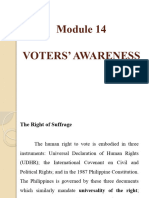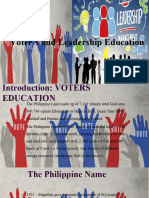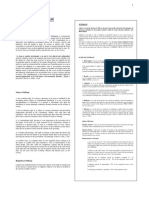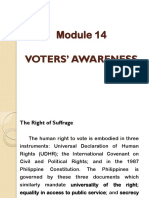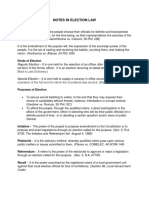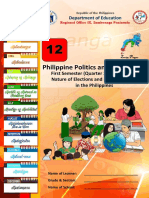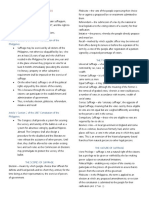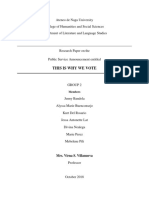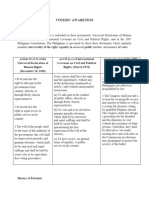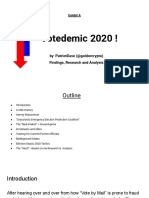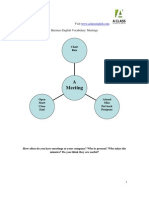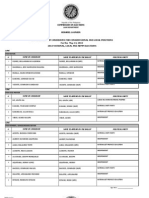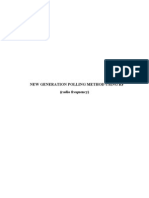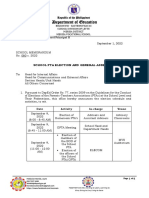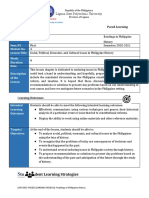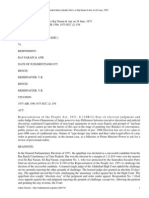Participate in local governance through development planning on the barangay
level, consultations and public hearings, and representation in local special
bodies, especially in the local development councils.
Aside from direct exercise of legislative power through the system of initiative
and referendum, citizen-voter can participate in legislation through legislative
advocacy, a process of engaging with the legislature and other governmental and
social institution to ensure that the concerns and welfare of the general electorate
be articulated in the deliberations of bills and other legislative measures as well
as in the final versions of laws.
The citizen voter can also engage in the political and electoral process in other
ways such as:
A. running for office.
B. supporting/campaigning for a political party, candidate, or party-list
group.
C. supporting initiatives of civil society organizations to ensure honest and
peaceful elections, eg. Election monitoring
D. making views known to the elected representatives.
This module is prepared by the
Consortium on Electoral Reforms (CER) and
United Nations Development Programme (UNDP)
With support from the
European Union(EU) and
The United Nations Democracy Fund (UNDEF)
2nd printing
� Your Vote. Our Future. Citizen-Voter Education Module
I. The Right to Suffrage
The human right to vote is embodied in three instruments: the Universal Declaration of
Human Rights (UDHR); the International Covenant on Civil and the Political Rights; and
the 1987 Philippine Constitution. The Philippines is governed by these three documents
which similarly mandate the universality of the right; equality in access to public
service; and secrecy of votes.
Article 21 (1-3) of the Art.25 (a-c) of the International Art. V, Sec. 1-2 of the
Universal Declaration of Covenant on Civil and Political 1987 Philippine Constitution
Human Rights Rights, (March 1976)
(December 10, 1948)
1 Everyone has Every citizen shall have the 1 Suffrage may be exercised
the right to take right and the opportunity, by all citizens of the
part in the without any of the distinctions Philippines not otherwise
government of his mentioned in article 2 and disqualified by law.
country, directly or without unreasonable
through freely restrictions: 2 The Congress shall
chosen (a) To take part in the provide a system for securing
representatives. conduct of public affairs, the secrecy and sanctity of
directly or through freely the ballot as well as a system
2 Everyone has chosen representatives; for absentee voting by
the right to equal (b) To vote and to be qualified Filipinos abroad. The
access to public elected at genuine congress shall also design a
service in his periodic elections which procedure for the disabled
country. shall be by universal and and the illiterates to vote
equal suffrage and shall without the assistance of
3 The will of the people shall be held by secret ballot, other persons.
be the basis of the authority guaranteeing the free
of the government; this will expression of the will of Until then, they shall be
shall be expressed in the electors; allowed to vote under existing
periodic and genuine (c) To have access, on laws and such rules as the
elections, which shall be by general terms of Commission on Elections may
universal and equal suffrage equality, to public promulgate to protect the
and shall be held by secret service in his country. secrecy of the ballot.
vote or by equivalent free
voting procedures.
2 27
�Your Vote. Our Future. Citizen-Voter Education Module
4 25
� Your Vote. Our Future. Citizen-Voter Education Module
VI. Voter Behavior and Elections
A 2003 IPER update study on voter behavior suggests the top four factors
determining the vote of Filipino electorate:
candidate’s public servant image;
political machinery;
candidate’s popularity; and
endorsement of a traditional network and organizations which include the
family, the church, the ward leaders, and formal groups and associations.
According to the March 2004 Pulse Asia Survey, the youth do not differ from other
age groups in their desired traits for a national leader (top traits were: pro-poor, is
knowledgeable and has experience in management of government, trustworthy, can
enforce the law equally for influential and ordinary people, prays often to God, godly,
sincere, and fights anomalies in government).
In March 2007, Pulse Asia conducted the same survey, with the following results as
Aquino’s program of restoring democracy, promoting stability, and establishing political
the most important characteristics that a national leader should posses: hard working,
legitimacy involved three major electoral exercises: a national plebiscite for the approval of
relates well to others, can give hope to most Filipinos, has integrity and a good
the 1987 Constitution in February 1987; the election for members of the Senate and
reputation, produces good results, announces his/her stand on important issues and
House of Representatives in May 1987; and local elections in January 1988. The 1987
his/her proposed programs.
Constitution provided for a multi-party system.
Furthermore, it has been reported that about 79% to 90% of registered voters below
During the 1992 synchronized national and local elections, the people voted for president
55 years old were aware of political ads in 2004 and with a slight increase to 88% to
for the first time under the 1987 Constitution. The main campaign issue was doing away
94% in 2007.
with “trapo” or traditional politics. In 1995, congressional and local elections were held. A
new form of fraud dubbed as “dagdag-bawas” or the subtraction of votes from one
The conduct of elections is made complex by the practices and values, which in turn
candidate to be added to the contending candidate was a practice during these two major
are reflective of the behavior and attitudes of the electorate and the politicians and of
elections.
the actual practices before, during, and after elections. Further, voter behavior reflects
the personalistic and patronage orientation of traditional Filipino politics or “trapo.”
In 1998, the first party-list elections were held. Joseph Estrada was elected as President
of the Republic with popular support. However in January 2001, Estrada stepped down as
Patronage politics thrive in a culture where the government leader becomes a
president due to cases of plunder. Gloria Macapagal-Arroyo was installed as president.
politician who serves as a patron accommodating special favors to dole out money or
provide jobs, recommendations, and contracts to only a few in exchange for votes in
Four months later, senatorial and local elections were held simultaneously which proved
the succeeding elections or support for a political agenda.
to be a major victory for the new administration after its allies gained a majority in both
Houses of Congress, along with winning most of the elected local posts.
A common element of patronage culture is utang na loob. The powers-that-be use
this to ensure that their political and economic interests will be served. For instance, a
However, President Arroyo had become so unpopular that, by 2004, she only narrowly
“powerful” politician may invite a candidate to run under his political party and in
won over her closest rival, actor-turned politician Fernando Poe, Jr. A year later, in June
return, the candidate will feel indebted and - eventually feel pressured to support the
2005, President Arroyo was confronted by the “Hello, Garci” controversy, wherein her
alleged taped conversations with COMELEC Commissioner Garciliano with the intent of political agenda of his benefactor (even if he is opposed to said agenda).
rigging the elections was leaked to the media. This generated large street demonstrations,
reminiscent of EDSA I and II.
6 23
�Your Vote. Our Future. Citizen-Voter Education Module
The Constitution lays down specific criteria on who can become public servants.
During the 2010 elections, we voted for the 15th president of the Republic of the
Philippines. At the same time, we voted for a new vice-president as well as 12 senators, a
number of representatives and local government officials.
The President
The President is the head of the executive branch of the government. In order to run for
the position, aspirants should be:
1. natural born citizen of the Philippines;
2. a registered voter;
3. able to read and write;
4. at least forty years of age on the day of the election and;
5. a resident of the Philippines for at least ten years immediately preceding election.
The Vice-President
In the event that the President is unable to perform his/her duties because of death or
permanent disability, or should the president be impeached, the Vice-President shall take
over the responsibility of running the exectuive department.
The Vice- President shall be elected and can be removed from office in the same manner
as that of the President.
The Senate and the House of Representatives
Where no President and Vice President shall have been chosen or shall have qualified, or
where both shall have died or become permanently disabled, the President of the Senate
or, in case of his/her inability, the Speaker of the House of Representatives, shall act as
President until a President or a Vice President shall have been chosen and qualified.
y(1987 Philippine Constitution)
Those who wish to run for Senate should have the same qualifications as that of the
President or Vice-President except that he/she need only be 35 years old and above.
Those who intend to run for the lower house should at least be 25 years old and should
possess the same qualifications as that of the President, et al.
Aside from the general qualifications required of the political candidates, voters must also
consider looking into the candidates’ track records.
8 21
� Your Vote. Our Future. Citizen-Voter Education Module
Specific Electoral Mechanisms
Since the enactment of the 1987 Constitution, elections for President and Vice-
president are held every six years, while elections for Senators and members of
the House of Representatives and local government officials occur every three
years.
At the local level, barangay elections and Sangguniang Kabataan elections are
also held periodically.
From 1993 onwards elections for the Autonomous Region of Muslim Mindanao
(ARMM) were held. The 1996 and the 2008 ARMM elections also served as a
pilot-test for the automated system of elections.
The party-list system of representation allows for marginalized and
underrepresented sectors to be represented in the national legislature. The
system serves as an attempt to depart from the personalistic character of the
political and electoral system by giving focus to the party and its issue-based
platform.
The latest development in upholding the right of suffrage is constituted in
Republic Act 9189, which provides for a system of absentee voting for qualified
Filipinos abroad.
Aside from voting in elections, our Constitution mandates other mechanisms and venues
to advance democratization and citizen’s participation in governance:
The system of referendum, which is consultative in nature, gives people the
power to directly enact or reject laws both at the local and national levels.
Meanwhile, through plebiscite, the people initiates to make a decision whether
to approve or reject the call for a constitutional convention to propose changes to
the Constitution, approve or reject proposed changes in the Constitution and, at
both the local and national levels, express their will with respect to certain issues.
A leader can be removed in office when the people are not satisfied with his/her
performance. This can be done through recall.
Also through people’s initiative, the people may directly propose amendments
to the Constitution by a petition of at least 12% of the total number of registered
voters, in which 3% of registered voters in each legislative district is represented.
10 19
�Your Vote. Our Future. Citizen-Voter Education Module
The voting period is from 7:00 am until 6:00 pm. Before voting starts, BEI shows the
empty ballot box, turns on/ initializes PCOS machine, and prints Initialization Report or
“Zero Report” to show that there is no entry/vote in the machine’s memory.
Casting of Votes
The casting of votes shall proceed in the following manner:
The voter looks for his/her name in the list of voters
posted outside the polling place.
The voter presents an ID to the BEI in assigned
clustered precinct.
Upon verifying the voter’s identity, BEI gives voter a ballot containing the list of
candidates for various vacant elective positions.
The voter shades, the entire oval ( ) corresponding tto her/his choice of
candidate, using a special marker.
Voter personally feeds the accomplished ballot into the PCOS Machine. The
ballot will go straight to a translucent ballot box. The machine will store the data
and take a photo of the ballot.
The BEI member marks voter’s finger with indelible ink.
Counting, Canvassing, and Transmittal of Votes
After voting ends at 6:00pm, the voter continues to be vigilant in the counting, canvassing,
and transmittal and canvassing of votes.
The BEI executes a closing function on the machine to prevent it from accepting
additional ballots/votes. The machine automatically starts automated counting of
the votes and prints eight (8) copies of the Election Returns (ERs).
The BEI distributes the initially printed ERs. One copy is posted outside the
precinct for public viewing.
The BEI attaches transmission cable/modem to the machine.
The BEI performs transmission function which starts transmittal of data to the (a)
Municipal Board of Canvassers (MBC); (b) COMELEC central database; and (c)
data server of accredited groups including the Kapisanan ng mga Broadcasters
sa Pilipinas (KBP), political parties, and citizens’ arm thru the machine. After the
transmission, BEI performs a function for the machine to print the remaining
twenty-two (22) copies of the ERs for other accredited parties.
12 17
� Your Vote. Our Future. Citizen-Voter Education Module
Features of the System Security Measures
The Election Automation Law provides for the following features of the automated system: Aside from the previously mentioned safeguards, the automated election system has the
a) use of appropriate ballots; b) stand-alone machine which will count and following security measures:
consolidate elections results; c) provision for audit trails; d) minimum human
intervention; and e) adequate safeguard and security measures. Use of password and personal identification number (PIN)
Digital signatures of BEI Members
Official Ballot Encryption, the same security system used by banks (i.e., 128-bit encryption,
The official ballot consists of an oval shaped paper ballot corresponding to the pre-printed random encryption, no single/master decryption code)
names of candidates. The ballot accommodates 300 names of candidates, with 150 Less-than-2-minute transmission speed
names per side of the ballot. To prevent tampering and use of fake ballots, the ballot has a Multiple data source (i.e., paper ballot, digital ballot image, scanned data)
watermark and ultraviolet (UV) features, and one barcode which corresponds to each Hard copies for distribution
ballot. A designated color will correspond to the different elective positions. A marking pen o 30 copies of election returns at the precinct level
will be provided by the BEI during Election Day. o 30 copies of certificate of canvass at municipal level
The voter personally feeds the ballot into the machine at any orientation. The machine o 14 copies of certificate of canvass at provincial level
scans both sides of the ballot simultaneously and generates and stores a digital image. Audit Log
Data storage device
Stand-Alone Machine Transmitted data (i.e., results, reports)
Throughout the voting process until the printing of the initial eight (8) copies of election Activity reports (i.e., Initialization/Zero Report, Transmission Reports, Audit Log)
returns, the PCOS machine is not connected to any transmission cable or modem. Only Series of systems tests (i.e., mock election, testing and sealing, 2 areas etc.)
after the printing of initial ERs will the BEI connect the links for transmission to eliminate
Back up batteries (16 hours capacity)
doubts that the PCOS can be manipulated remotely.
Back up PCOS units
Audit Trail
The machine generates an audit log which documents and reports the activities processed The PCOS – Precinct Count
by the machine at a particular date and time. A random manual audit will be conducted in Optical Scan used in the first
randomly-selected precincts chosen by the Commission thru a composite committee with Philippine Automated National and
representation from a citizen’s arm. Local Elections in 2010
Minimum human intervention
The voter personally feeds the ballot into the machine, while only the BEI members Pre-Election Phase
operate the PCOS. Transmission is done electronically, with sufficient system back-up.
Registration
Preliminary to the voting exercise is the registration of voters. The registration process is
guided by RA 8189 or the Continuing Voters’ Registration Act of 1996 and by COMELEC
Resolution No. 8514 rules and regulations on the Continuing Registration of Voters. The applicant's identity and residence will be verified thru presentation of a valid ID with
photograph and signature. The applicant's status of registration will also be verified. After
During the registration process, qualified applicant will have to appear personally at the a successful verification, the applicant shall receive and fill out an application form in three
local COMELEC office. (3) copies.
The applicant's biometrics will then be digitally captured, i.e., digital images of a voter’s
photograph, fingerprints, and signature will be taken using COMELEC's Data Capture
Machine (DCM). An Acknowledgment Receipt will be given to the applicant afterwards.
14 15


